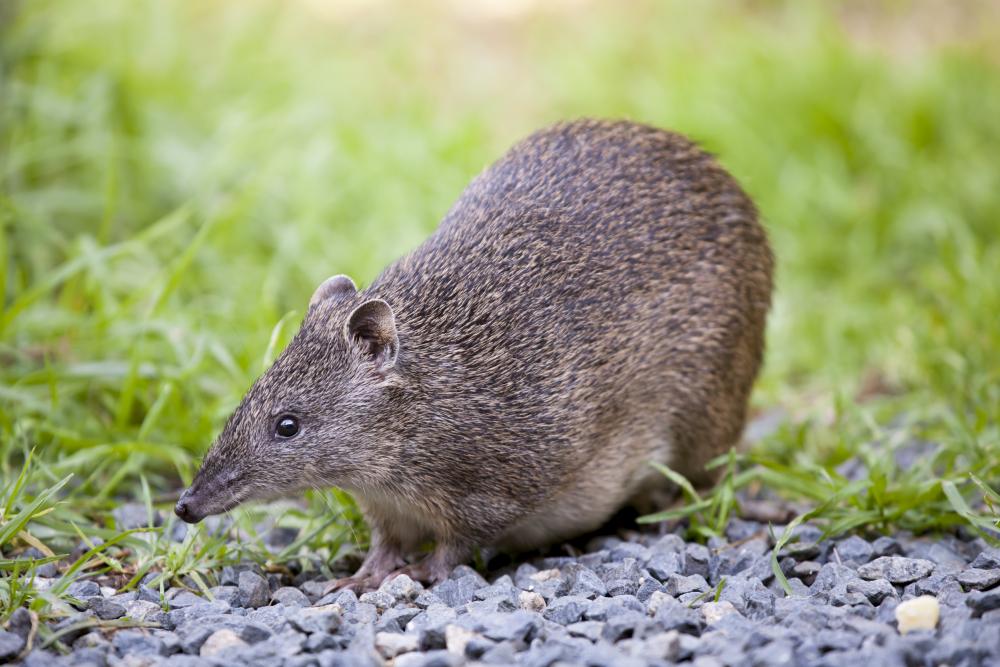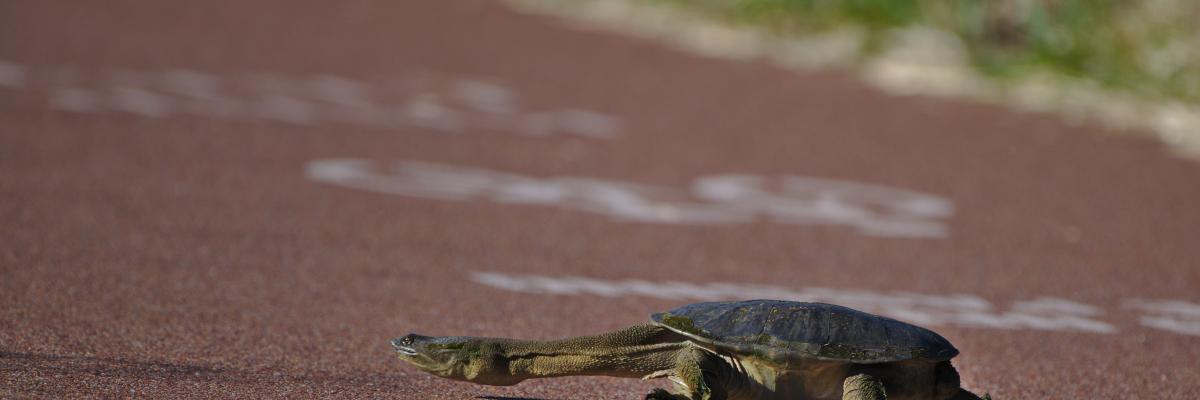Turtles
Southwestern Snake-necked Turtles occur within various seasonal and permanent waterbodies within the City of Gosnells. Whilst they spend most of the year within the water, females will leave the water to lay their eggs during the nesting season.
Nesting occurs later in the year with two distinct seasons: Spring ( September - November ) and Summer ( December - February ), with nesting appearing to be triggered by low pressure systems.
Females may travel 800m ( or more ) from the water to lay her eggs, though most nests are laid within 500m. The whole process of looking for a nesting site, digging the nest, laying her eggs, refilling and compacting the nest, and returning to the water can take place over several hours. During this time they are very vulnerable to predation, especially from foxes and vehicle strikes.
Hatchlings emerge from May to August, when the tiny ( shell length 3cm ) hatchlings make their way to the water.
Recent research into population numbers in wetlands across Perth show declines in turtle numbers, particularly females, and low recruitment, with few juvenile turtles recorded. Predation and vehicle strike of female turtles during nesting season, as well as predation of eggs are major threats to our turtles.
What you can do to help
- Slow down and keep an eye out for turtles around wetlands ( including when riding bikes on pathways )
- Walk dogs on short leads during nesting and hatching season
- If you see an adult turtle on land DO NOT return it to the water as it is likely a nesting female and if she has not yet laid her eggs, this may cause her to abort them, or she will have to start her journey all over again
- If you see a turtle crossing the road monitor it until it has safely crossed the road, if it is necessary to move the turtle, place it on the side of the road in the direction is was travelling
- If you see a turtle being harassed by Ravens check to see if she is trying to nest, Ravens have been known to harass females until they abandon their nesting attempt, then eat the eggs. If she is laying you can assist by shooing away the Ravens until she has finished laying and has covered the nest
- If you see a hatchling, you can take it to the nearest wetland
- Educate your friends, family, and community and help spread the word
If you see a sick or injured turtle contact the Turtle Oblonga Rescue and Rehabilitation Network on the following numbers:
East Metro - 0425 727 411
South Metro - 0424 727 624
North Metro - 0414 476 867
The City installs temporary signage in areas where turtles are known to cross roads. Keep and Eye out for signs during spring and slow down and watch for turtles.
Link: Turtle Oblonga Rescue & Rehabilitation Network - http://www.turtleoblonganetwork.org.au/
Magpies
During the start of breeding season male Magpies may swoop people ( and domestic animals ) that they think may be a threat to their young. Swooping can cause some people distress, and on occasion injury, but there are things we can all do to reduce the chance of being swooped, and to protect ourselves in case we are.
Avoid: the best thing to do is to avoid the area where Magpies swoop for a period of four to six weeks.
Protective clothing: wearing protective clothing such as hats ( especially wide brimmed hats ) and glasses can reduce the chance of being injured if a Magpie does make contact whilst swooping. It can help to look towards the ground in an area where Magpies swoop to reduce the chance of eye injury in case that contact is made. If you feel the need to use items such as umbrellas and sticks as protection use the umbrella as you would if it were raining, and hold any objects still above your head - don't wave them around. The idea is to create a barrier between you and the Magpie should it make contact.
Stay calm : getting swooped can be scary for some people but it is important to remember that your behaviour affects the Magpie's behaviour. If you react in a threatening way ( running, screaming/yelling, swinging your arms and objects around ) the Magpie is likely to see you as a threat and is more likely to swoop you ( and others using that area ). The best thing to do is to remain calm ( even if being swooped! ). Walk in a steady manner and maintain a constant pace ( don't run ), keep your hands and arms down, and whilst talking is fine, avoid raising your voice ( no yelling/screaming ).
Remember, Magpies are native animals that are protected under Federal and State legislation. Whilst swooping Magpies can cause distress and in some cases injury, only a small percentage of male Magpies will swoop during the start of the breeding season to protect eggs and young chicks from perceived threats.
The City installs temporary signage in areas where swooping Magpies have been reported. Keep an eye out for signs during spring and avoid these areas if possible.
Quenda
The Quenda ( Isoodon fusciventer ) is a native bandicoot which is endemic to the south-west of Western Australia and occurs throughout the Perth Region. Whilst they are mostly nocturnal, they can been seen during the day, particularly during winter.
Quenda are omnivorous, eating fungi, roots, tubers, and other plant matter, as well as invertebrates and occasionally small vertebrates such as skinks. Quenda dig for their food, leaving characteristics conical shaped holes. This digging behaviour makes them ecosytem engineers, as they turn over the soil and leaf litter, increasing the moisture and humus levels in the upper soil.
Quenda can be easily distinguished from introduced rats by their larger size and rounder shape, long pointed snout, lighter colour, and short tail relative to body size ( in some case they may have little to no tail as they lose them from fighting ).

Snakes
The two most common venomous snakes found in the Perth Region are the Tiger Snake, and the Dugite. Tiger Snakes are more common in wetland areas, with Dugites typically being found in drier bushland areas.
Snakes are more active in the warmer months, but it is worth being vigilant year round. To minimise your chances of having a negative interaction with a snake you can undertake the following precautions:
- Take care when walking in bushland and grassy areas, and only walk where you can see the ground around you.
- Keep a watchful eye on the ground around a metre or so in front of you as you walk.
- When bushwalking, wear long trousers and fully enclosed footwear.
- Around the home, remove long grass and items lying on the ground which may provide a cover for snakes.
- Reduce mice numbers around the house ( mice, other small mammals, frogs and lizards are the primary food sources for Dugites and Tiger Snakes ).
If you find a snake, do not approach it or aggravate it in any way. Most bites occur when people accidently step on snakes, or while attempting to kill them.
If you find a snake on your property and want it removed, contact a licensed snake catcher, do not attempt to remove it yourself.
Note, City of Gosnells Rangers do not remove snakes.
Seasonal Wildlife Sightings
The City has a number of temporary signs which can be used to notify the public of seasonal wildlife activity such as breeding movements of turtles, ducklings, breeding birds, and reptiles. The signage aims to encourage people to slow down and take care.
